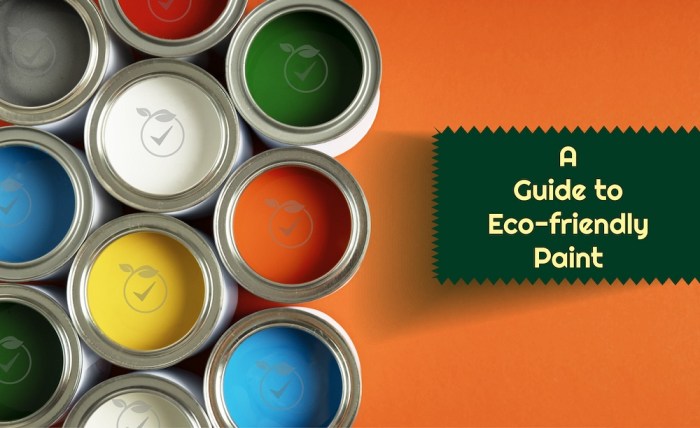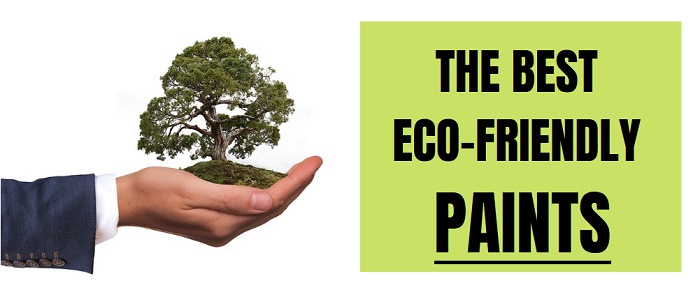Embark on a journey into the world of eco-friendly house paint options, where sustainability meets style and health. Discover the innovative solutions available in the market that not only beautify your living spaces but also contribute to a greener environment.
Delve deeper into the realm of eco-friendly paints and uncover the myriad benefits they offer over traditional paint choices.
Eco-Friendly House Paint Options
When it comes to painting your home, opting for eco-friendly house paint can have numerous benefits for both your health and the environment. These paints are made from natural ingredients and do not contain harmful chemicals commonly found in traditional paints.
Types of Eco-Friendly House Paints
- Zero-VOC Paints: These paints contain little to no volatile organic compounds, reducing harmful emissions into the air.
- Milk Paint: Made from milk protein, lime, and natural pigments, this paint is biodegradable and non-toxic.
- Clay Paint: This paint is made from clay, natural pigments, and mineral fillers, offering a breathable finish.
- Plant-Based Paints: Derived from ingredients like plant oils, resins, and waxes, these paints are low in toxins.
Benefits of Eco-Friendly Paints
- Improved Indoor Air Quality: Eco-friendly paints release fewer pollutants, creating a healthier indoor environment.
- Reduced Health Risks: By avoiding harmful chemicals, these paints help reduce the risk of respiratory issues and allergic reactions.
- Environmentally Friendly: Eco-friendly paints are biodegradable and have minimal impact on ecosystems when disposed of.
Natural Ingredients in Eco-Friendly Paints
- Linseed Oil:Used as a binder in many eco-friendly paints, linseed oil is derived from flaxseeds and offers a durable finish.
- Citrus Extracts:Some paints use citrus extracts as solvents, providing a pleasant smell and reducing the need for harsh chemicals.
- Beeswax:Beeswax is sometimes used as a natural preservative in eco-friendly paints, enhancing durability.
Types of Eco-Friendly House Paints
When it comes to eco-friendly house paints, there are various options available that are better for the environment compared to traditional paints. Two popular types are water-based paints and plant-based paints, each with its own set of characteristics and benefits.
Water-Based Paints vs. Plant-Based Paints
Water-based paints are made with water as the primary solvent, making them low in volatile organic compounds (VOCs) and easy to clean up with water. They are known for their quick drying time, durability, and versatility in application. On the other hand, plant-based paints are made from natural ingredients such as plant oils, resins, and extracts.
They are biodegradable, emit fewer harmful chemicals, and have a unique finish that can enhance the aesthetic of a home. While water-based paints are more commonly used and widely available, plant-based paints are gaining popularity for their sustainable and non-toxic properties.
Differences Between Low-VOC, Zero-VOC, and VOC-Free Paints
- Low-VOC paints contain reduced levels of volatile organic compounds, making them less harmful to indoor air quality compared to traditional paints.
- Zero-VOC paints have no VOCs or very minimal levels, making them a safer option for those who are sensitive to chemicals or have respiratory issues.
- VOC-free paints are completely free of volatile organic compounds, ensuring minimal impact on indoor air quality and the environment. These paints are the most eco-friendly option available in terms of VOC emissions.
Certifications and Labels
When purchasing eco-friendly paints, consumers should look for certifications and labels that indicate the paint meets certain environmental standards. Some of the certifications to watch out for include:
Green Seal
Ensures the paint meets strict environmental criteria and performance standards.
Greenguard
Certifies that the paint has low chemical emissions, promoting better indoor air quality.
USDA Certified Biobased Product
Indicates that the paint is made from renewable biological resources
Application and Performance

When it comes to applying eco-friendly paints, proper surface preparation is key to ensure a smooth and long-lasting finish. This includes cleaning the surface thoroughly, repairing any imperfections, and using a primer if necessary.Eco-friendly paints generally have good coverage, but it is important to follow the manufacturer's guidelines for the specific product you are using.
The drying time for eco-friendly paints is usually comparable to traditional paints, but it can vary depending on factors like temperature and humidity.In terms of longevity, eco-friendly paints are known to be durable and long-lasting. They are resistant to fading, yellowing, and cracking, which helps maintain the appearance of the painted surfaces over time.
Performance in High-Traffic Areas
Eco-friendly paints perform well in high-traffic areas due to their durability and resistance to wear and tear. They are able to withstand frequent cleaning and scrubbing without losing their color or finish. Using a topcoat or sealer can further enhance the durability of eco-friendly paints in high-traffic areas.
Performance in Humid Environments
Eco-friendly paints are also suitable for humid environments as they are breathable and resistant to mold and mildew growth. This makes them a great choice for bathrooms, kitchens, and other areas with high moisture levels. However, it is still important to ensure proper ventilation in these spaces to prevent any moisture-related issues.
Cost and Availability

When considering eco-friendly paints versus traditional paints, one key factor to take into account is the cost. Eco-friendly paints tend to be slightly more expensive than their traditional counterparts due to the use of higher quality, non-toxic ingredients. However, the long-term benefits of using eco-friendly paints, such as improved indoor air quality and reduced environmental impact, often outweigh the initial cost difference.
Cost Difference
On average, eco-friendly paints can cost anywhere from 10% to 40% more than traditional paints. This cost difference can vary depending on the brand, quality, and specific ingredients used in the paint formulation. While the upfront cost may be higher, the durability and health benefits of eco-friendly paints can lead to cost savings in the long run.
Availability
Consumers can purchase eco-friendly paints from a variety of sources, including online retailers, local stores, specialty eco-friendly stores, and even some major home improvement retailers. Many paint manufacturers now offer eco-friendly paint options as part of their product lines to cater to the growing demand for sustainable and non-toxic paint products.
Government Incentives
Some governments and local municipalities offer incentives or programs to promote the use of eco-friendly paints. These incentives may include tax credits, rebates, or grants for homeowners or businesses that choose to use eco-friendly products. By incentivizing the use of sustainable paints, governments aim to reduce harmful emissions and promote healthier living environments for their citizens.
Summary

As we conclude our exploration of eco-friendly house paint options, remember that making environmentally-conscious decisions can have a lasting impact on our homes and planet. Embrace the beauty of eco-friendly paints while safeguarding your health and the environment.
FAQ Section
What are VOC-free paints?
VOC-free paints are those that contain little to no volatile organic compounds, making them safer for indoor air quality and human health.
Where can I find eco-friendly paints?
Eco-friendly paints can be purchased from online retailers, local stores specializing in green products, or eco-friendly home improvement stores.
Are eco-friendly paints more expensive than traditional paints?
While initial costs may be slightly higher, eco-friendly paints often provide better coverage and durability, making them a cost-effective choice in the long run.









